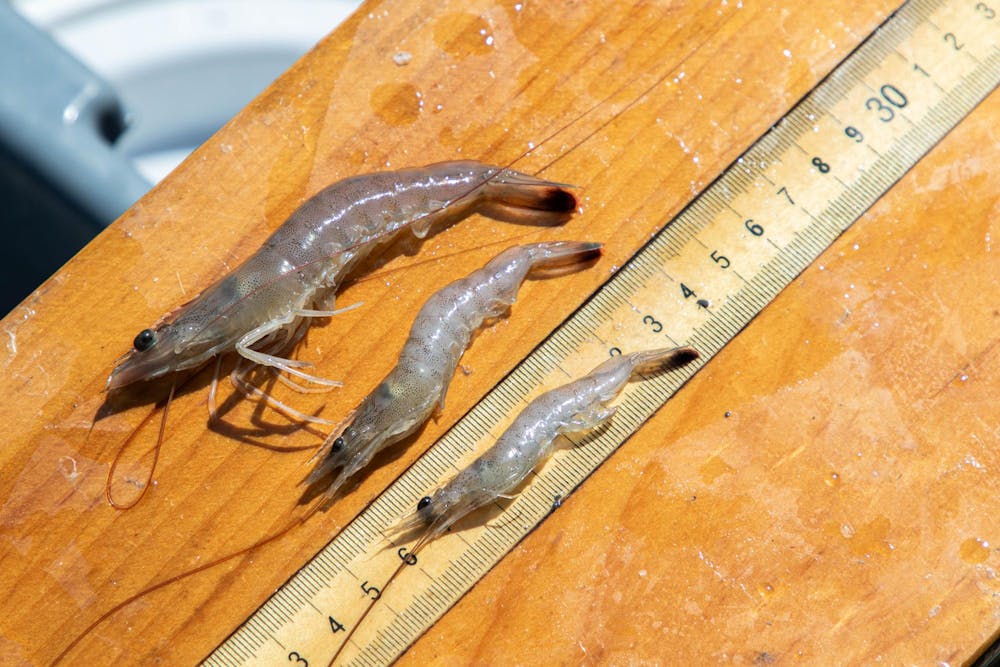Researchers from USC's Baruch Marine Institute, as part of the Lowcountry Shrimp Collaborative, have begun publishing their research on the impacts of rising water temperatures in Lowcountry estuaries on the life cycles and migratory patterns of penaeid shrimp.
The study found that rising temperatures have created expanding ranges for penaeid shrimp, leading to increased populations farther north and longer shrimping seasons.
The collaborative was comprised of researchers from various marine science facilities across the southeast, including the South Carolina Department of Natural Resources (SCDNR) and the University of South Carolina Baruch Marine Institute. From late 2021 to mid-2025, the Lowcountry Shrimp Collaborative collected field samples analyzed historical data sets of shrimp migration patterns dating back nearly 40 years.
The Baruch Marine Institute's field research lab is located on the Hobcaw Barony reserve in Georgetown, South Carolina, and is part of USC’s School of the Earth, Ocean and Environment.
The focus of the collaborative’s research was white, brown and pink penaeid shrimp, three species of shrimp sought by commercial shrimpers in the Lowcountry, and how rising water temperatures were affecting shrimp development and migration.
Fourth-year marine science doctoral student Liam Batchelder joined the program in late 2022 as part of his PhD research with the Baruch Marine Institute.
“This project was collaborative and worked with multiple universities and worked with state agencies,” Batchelder said. “I was really excited to be part of this team, studying shrimp and other organisms and how they're being influenced by changing environmental conditions.”
The project was funded by a federal grant from the National Estuarine Research Reserve Science Collaborative, a department of the National Oceanic and Atmospheric Administration (NOAA).
Baruch Institute research affiliate Robert Dunn and Assistant Director Matt Kimball worked as principal investigators on the project and contributed to the research proposal that earned the collaborative its funding. Dunn and Kimball joined the Lowcountry Shrimp Collaborative in late 2021.
“We, in our proposal, linked up with other researchers in the Southeast ... who were working on similar research questions,” Kimball said. “‘How do animals with complex life histories use these estuaries?' or 'How do they complete their life cycle?'"
SCDNR associate marine scientist Michael Kendrick served in a supervisory role throughout the collaborative’s research, but SCDNR as an organization worked on all stages of the project.
“We had field biologists in the field helping to collect the samples ... We were heavily involved in both the data collection, data analysis, report writing, manuscript writing, leading the publication of a manuscript," Kendrick said. "We've really been an active collaborative participant in this project, and I've been really excited to be able to be a part of what's been a fantastic team.”
Field analysis was performed in three national estuarine research reserves (NERRs): North Inlet-Winyah Bay, ACE (Ashepoo, Combahee and Edisto Rivers) Basin and Sapelo Island in Georgia, Batchelder said. NERRs are protected sites and relatively untouched by the effects of human activity, Dunn said.
“Those are sites that are selected for protection, for research, for stewardship, for education, and so because we're working in those places, they're special,” Dunn said. “We were fortunate that we were working in mainly fairly pristine locations relative to a lot of the coastline.”
The researchers spent a few days each month in the field, collecting samples of water and estuarine organisms from all three NERRs, Batchelder said. They would then identify and analyze their samples back in a lab setting.
“The majority of my work was done in the field ... If there were things that we couldn't identify, we would bring them back, and I would have to identify them under the microscope,” Batchelder said. “Ideally, what you end up with is a bunch of Excel files of numbers, and those will have counts and those will have identities of different species.”
The collaborative also worked with commercial shrimpers from the Lowcountry to determine how these environmental changes would impact the industry, Batchelder said. Kendrick said the changes in shrimp populations could indicate change across other estuarine species.
“Something that we hear from commercial fishers often is that things are different now than they used to be," Kendrick said. "(Shrimp) distribution across the estuary at different times of the year is different than they used to be, and that has important implications for shrimpers."

Batchelder hesitated to judge whether rising temperatures and climate change were going to positively or negatively impact penaeid shrimp but said their migration patterns and ranges would likely continue to change as rising temperatures would allow the shrimp to stay in estuaries for longer into the winter.
“It's definitely going to change where we find shrimp, not just in South Carolina, but all the way across their range. We're seeing shrimp farther north than we ever used to see them,” Batchelder said. “There's enough of them now in the Chesapeake Bay and (off) the coast of Maryland and Virginia that they're actually able to support small fisheries. That was never possible before.”
Looking forward, Kendrick said the Lowcountry Shrimp Collaborative was just the beginning of future estuarine ecosystem research.
“I think the research team has been really great at working collaboratively and putting their heads together to try and understand the state of the shrimp resource across the state and across the region,” Kendrick said. “There's a number of different avenues that we'll be able to jump off from, using this project, using this team as a starting point to help us even further understand ... some of these things that may help us to, maybe in the future, better forecast potential changes to shrimp population that may be informative to members of the public.”

